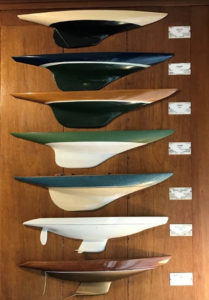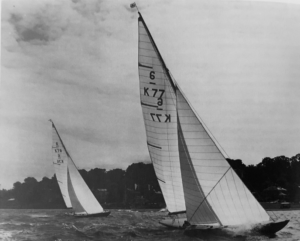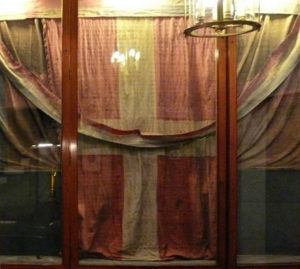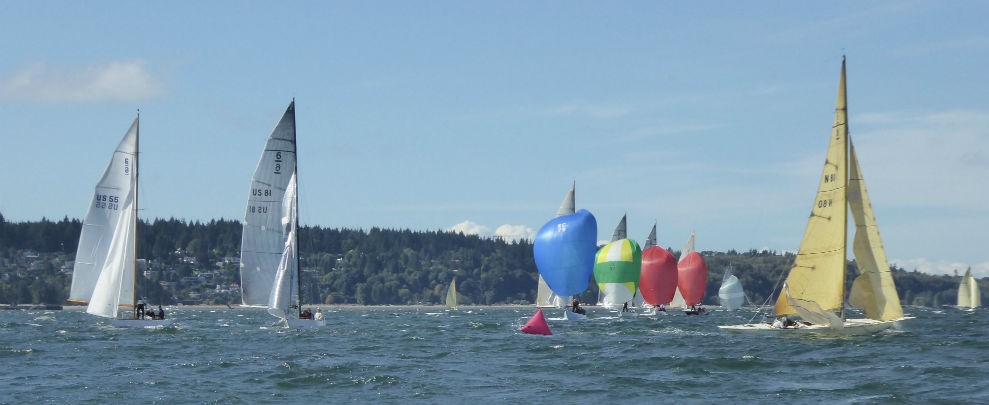Feature contributor: The Royal Thames Yacht Club
April 6th, 2020
The Royal Thames Yacht Club

Sailing on the Thames in the 18th Century.
Founded in 1775, the Royal Thames Yacht Club was already 132 years old when the first Six Metre took to the water. The Club’s first recorded race was held on the Thames in July 1775 for a silver cup – the first Cumberland Cup – put up by the Duke of Cumberland, younger brother of King George III. The competing boats were of a very different type to the modern racing yacht. It was not until the 1840s that racing on the open waters of the South coast and Solent began to be popular, the change made possible by the advent of steam trains. One might be forgiven for thinking that, having discovered the open sea, ocean racing was a natural progression but it was not until 1887, the year of Queen Victoria’s Golden Jubilee, that a race ‘the like of which had never been known in the annals of yacht racing’ was announced by the Royal Thames Yacht Club over a course of 1,520 nautical miles round the British Isles.
Despite being the oldest continuously operating yacht club in the world and the first ‘Royal’ yacht club, this is probably not the image perceived by those in contact it. The Knightsbridge Clubhouse, arguably the most pleasant re-built London club, is a haven for yachtsmen and women who want a relaxing and exclusive land base in London. The membership also includes a vibrant Younger Members section and our trophy-winning Academy which aims to nurture and develop rising sailing talent.

The Royal Thames’ Britannia Bar is a relaxing area for members to meet.
Many of those using the Clubhouse are based overseas, being members of one of the 60 yacht clubs worldwide with whom we maintain reciprocal arrangements – equally useful for members when racing or cruising overseas. The Clubhouse has two bars, reading and meeting rooms, an excellent restaurant, private dining rooms and cabins for members staying in London. The meeting and dining rooms are also available to non-members as venue for conferences, meetings, dinners and even balls.

The club’s fleet of J/70s racing at Cowes.
The Club’s calendar has nigh on a hundred cruising and racing events at home and each year, providing ample opportunities for those without yachts to get on the water and likewise, equal opportunities for owners seeking crew. Our fleet of J/80 sports boats at Queen Mary Reservoir, Datchet and a further fleet of J/70s, based in Cowes allow for high level club racing. Both fleets are also available for charter. The Club welcomes new members who are involved in yachting and for more information see www.royalthames.com.
Involvement with the Six Metre Class
Despite the Club’s involvement in the formation of the Metre Rule in 1906, no evidence has yet come to light of ownership by members of very early Six Metres. The Club was always involved in The British American Cup, however, which was sailed in Sixes from the first race in 1921 until 1955. The Thames was heavily involved in re-establishing the Cup after The Great War and now is solely responsible, from the British side, for its continuance. We are pleased to report that we won it in 2019 (the latest contest at time of writing) although it was sailed in J70s.

The club’s collection of Six Metres.
Amongst our prized and extensive collection of half-hull models, there is a special area for Metre yachts and an individual board for some of the Six Metres owned by Club members. The boats shown, from top to bottom, are Zenith (1924), Lalage (1928), Circe (1937), Johan (1939), Royal Thames (1955), Scoundrel (1986) and Battlecry (1989). Curiously Bunty and Cremona, although winning the One Ton Cup in 1912 and 1913 respectively, are omitted as was Erica, being too recent to make the board.

Royal Thames (K77) and Marylette (K76) racing on the Solent in 1958.
As a club, our greatest involvement with the class was, unsurprisingly, with Royal Thames. In 1955 a syndicate of Club members paid to have a Six Metre built in order to participate in the truly international racing offered by the class. The first target was the British American Cup held in that year. Sadly the challenge was unsuccessful, her elegant cotton sails being no match for the American synthetic versions. Nonetheless, with 20 guns out of 33 starts, she made her mark. It was in 1958 when she really triumphed, winning the One Ton Cup, helmed by Col ‘Stug’ Perry, and taking 6 line-honours in Cowes Week, helmed by Michael Cream, amongst other successes. That apart, the Club premises have been a regular venue through the ages for planning both national and international event for the class.
The Club’s treasures

The 1914 Clyde Six Metre cup is on display in the clubhouse.
The Royal Thames is lucky enough to have several of the ‘Cumberland Cups’ dating to the 18th century amongst its extensive collection of trophies. This includes a number of trophies originally competed for by the Class including the Clyde Six Metre Points Cup and the original British American cup from 1921. A further connection is the Nelson Trophy which was donated to the International Six Metre Association by Don Wood of the Royal Thames Yacht Club. The trophy is awarded at the International Six Metre World and European Championships to the highest placed boat constructed and certificated between 1966 and 1979.
Amongst the Club’s oldest possessions are a set of flags consisting of an ensign, pennant and house flag, dating from the late 18th century. Of a slightly later vintage is a telescope reputedly once belonging to Admiral Lord Nelson.

The Club’s 18th century ensign, pennant and house flag are among the oldest objects in the collection.
The Club’s collection of yacht models is extensive, going far beyond the models of the Metre classes mentioned earlier. The half-model collection housed in the Model Room is one of the most comprehensive in the world, tracing the history of yacht design from the mid-19th century to the present day. Elsewhere around the Clubhouse are models from the days of the Cumberland Fleet, warships from the days of sail, steam yachts from the Edwardian era and famous club boats up the modern age.
We are extremely fortunate to have an extensive collection of marine paintings, lithographs and prints, many of which have an interesting history attached to them or their subject matter. Over the Club’s 245 year life a vast amount of paperwork has amassed, and providentially, successive Secretaries have preserved the core of it. We now have two archivists discovering hidden treasures on a regular basis. Amongst these are some superb photographs stretching back nearly 150 years.
We are proud of our club’s significant heritage collections, which are displayed throughout the Clubhouse for all members and visitors to enjoy. The collections not only enhance our members’ experience but also are an inherent part of the character of our historic organisation. We are delighted to able to share a small portion of our collections with a wider audience through our partnership with the Six Metre archive, giving a small insight into the archives and collections we care for. For more information about the Royal Thames Yacht Club’s heritage collections please contact the club through the website or at [email protected]. You can see the Club’s Six Metre archives here.
Andrew Collins, Head of Heritage, Royal Thames Yacht Club
Posted in Featured contributor by Jenny Wittamore on April 6th, 2020. Tags: collection, contributor, royal thames
Subscribe to comments You can skip to the end and leave a response. Pinging is currently not allowed.
We need your support
Support our project and submit your records or make a donation to the International Six Metre Archive.
